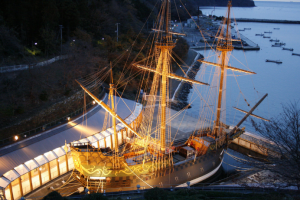 Forestry Asia Trade Mission delegates viewed first-hand how British Columbia wood products are contributing to the socio-economic recovery of Japan’s Tohoku region that was devastated by the March 2011 earthquake and tsunami.
Forestry Asia Trade Mission delegates viewed first-hand how British Columbia wood products are contributing to the socio-economic recovery of Japan’s Tohoku region that was devastated by the March 2011 earthquake and tsunami.
Mission delegates had the opportunity to visit the Donguri Anne Public Library and Yuriage Public Market in Natori City, and a replica of a famous Japanese historic sailing ship, the Sant Juan Bautista in Ishinomaki City.
“The citizens in the Tohoku region have made excellent progress in rebuilding since the devastating earthquake and tsunami and it’s an honour to continue the friendships that British Columbia and Canada have made in the community. We are delighted to learn that our donations have positively contributed to the economic revitalization of this region,” said Steve Thomson, British Columbia’s Minister of Forests, Lands and Natural Resource Operations.
The Donguri Anne Public Library and Yuriage Public Market, were two of four public buildings funded by the governments of Canada, British Columbia and Alberta under the $4.6-million Canada Tohoku Reconstruction Project.
The library serves Natori City’s 72,000 inhabitants and demonstrates how wood-frame public structures made with environmentally sustainable wood products from British Columbia and the rest of Canada are ideal building solutions. “Donguri” is Japanese for acorn, symbolizing regeneration, and “Anne” is an acknowledgement of “Anne of Green Gables”, Japan’s favourite Canadian novel.
The new Yuriage public market has served as a commercial hub and tourist destination. The rebuilt market draws 6,000 to 7,000 people daily on the weekends – an increase from the 3,000 to 4,000 visitors before the earthquake. Because of this increased popularity, public market officials have since added additional booth spaces to accommodate visitors.
Inspired by British Columbian timber frame design, the main pavilion integrates a food court, exterior deck and public meeting spaces. The project also consists of two additional separate structures which house seven commercial booths each, which were constructed in the platform frame method. Locally, it is nicknamed “Maple Hall” in recognition of Canada’s humanitarian assistance.
Natori City officials also showed trade mission delegates their plans for further reconstruction in the area.
During the 2011 Forestry Asia Trade Mission, Minister of Forests, Lands and Natural Resource Operations Steve Thomson met with the governor of the Miyagi Prefacture, at which time the vice-governor asked for replacement masts for the San Juan Bautista. This ship’s masts had been destroyed in the March 2011 earthquake.
The Sant Juan Bautista was a Japanese-built Spanish galleon that led an expedition from Miyagi Prefecture to Mexico and Europe in 1613 and is viewed as a symbol of the region’s outward engagement with the world. It is a local cultural treasure.
Western Forest Products was able to donate five specially harvested Douglas-fir and one western redcedar logs needed to replace the masts. The Sant Juan Bautista was fully reconstructed as a local historical treasure in time for the 400th Anniversary Celebration held in November 2013.
Trade missions are an important part of British Columbia’s international engagement strategy to support economic growth in priority sectors as well as BC Jobs Plan objectives. Maintaining and expanding markets, including strengthening key Asian markets, supports the Province’s goal of a diverse, globally competitive forest industry, outlined in Strong Past, Bright Future: A Competiveness Agenda for B.C.’s Forest Sector.

